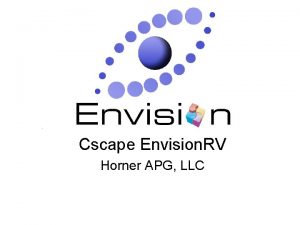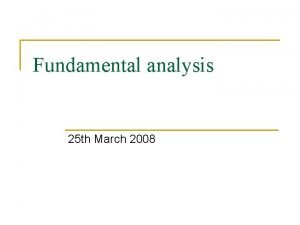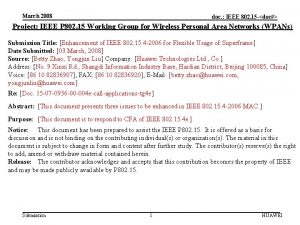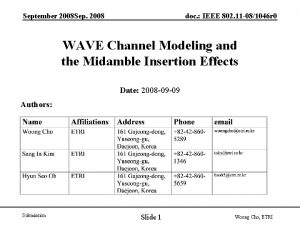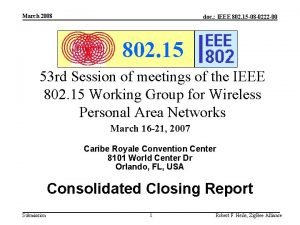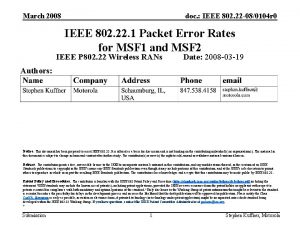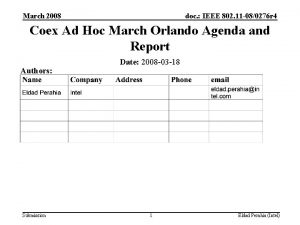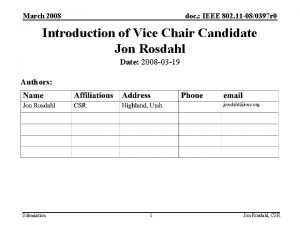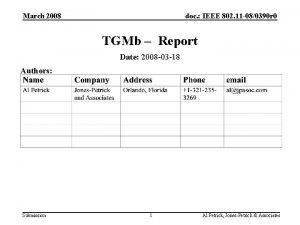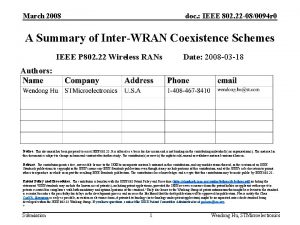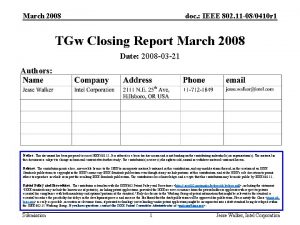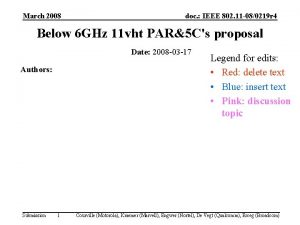March 2008 doc IEEE 802 11 080372 r














- Slides: 14

March 2008 doc. : IEEE 802. 11 -08/0372 r 3 Spectrum Mask in IEEE 802. 11 p Date: 2008 -03 -18 Authors: Submission Slide 1 Hanbyeog Cho (ETRI)

March 2008 doc. : IEEE 802. 11 -08/0372 r 3 Abstract • • We present the spectrum mask based on the FCC rule. WAVE system specification has mismatched spectrum masks. It means that PER(packet error rates) will be increased due to channel interference between adjacent channels. This presentation is a following work to the presentation by Vinuth Rai &John Kenny last San Fransisco meeting (17 July, 2008) The main focus is on the spectrum mask related FCC rule and the spectrum mask should fulfill [55+10 log(P)], -25 d. Bm criteria Then proposed spectrum mask will decrease the interference between adjacent channels Submission Slide 2 Hanbyeog Cho (ETRI)

March 2008 doc. : IEEE 802. 11 -08/0372 r 3 Contents • • Introduction Cross-Channel Interference Wave Regulation Spectrum Mask Submission Slide 3 Hanbyeog Cho (ETRI)

March 2008 doc. : IEEE 802. 11 -08/0372 r 3 Introduction • This presentation is relating to the presentation by Vinuth Rai &John Kenny last San Fransisco meeting(17 July, 2008) – 11 -07 -2133 -00 -000 p-cross-channel-interference-test-results-a-report-fromthe-vsc-a-project. ppt • Main focus : Interference adjacent channel – Spectrum Mask to fulfill [55+10 log(P)], -25 d. Bm criteria Submission Slide 4 Hanbyeog Cho (ETRI)

March 2008 doc. : IEEE 802. 11 -08/0372 r 3 Cross-Channel Interference • • Effect of cross-channel interference - Transmit power & channel allocation cross-channel interference - Increasing PER - Solution Need sharp spectrum mask Ce = Co – Ci - Ce : Total available channel - Co : Original channel - Ci : Channel interference Channel 1 Channel 2 Channel 3 Ce Interference Ci Submission Ci Ci Slide 5 Ci Hanbyeog Cho (ETRI)

March 2008 doc. : IEEE 802. 11 -08/0372 r 3 Cross-Channel Interference : Example – Using WAVE • □ Toyota ITC test Result : Adjacent interference Toyota ITC test Result : Non-adjacent interfer - Tx Channel : 172 - Control Channel: 178 - Tx Channel : 172 - Interferer Channel: 174 60 0% 40 0% 10% RX-Interferer Distance (meters) 30 0% 1% 80% 25 0. 5% 80% 99% 20 40% 90% 100% 15 0% 1% 40% 92% 95% 100% 12. 5 0. 10% 1. 50% 70% 98% 100% 10 0. 90% 35% 99% 100% 7. 5 15% 95% 100% 5 55% 98% 100% 2. 5 95% 100% 100% 15 25 50 100 150 200 Legend: PER > 10% RX-TX Distance (meters) □ Cross-channel interference test results - Adjacent channel interference. Packet Error: [Tx-Rx distance] / [Int-Rx distance] > 10 if [PTx =PRx] - Non-adjacent channel interference. Less importance Submission Slide 6 Hanbyeog Cho (ETRI)

March 2008 doc. : IEEE 802. 11 -08/0372 r 3 Wave Regulation □ Device classes and Tx power levels Device class Maximum device output power Class A 0 (d. Bm) 1 m. W Class B 10 (d. Bm) 10 m. W Class C 20 (d. Bm) 100 m. W Class D 28. 8 (d. Bm) 750 m. W □ Wave spectrum mask (D 3. 0) Reduction in Power Spectral Density, d. Br Device class 4. 5 MHz Offset 5. 0 Mhz Offset 5. 5 MHz Offset 10 MHz Offset 15 MHz Offset Class A 0 -10 -28 -40 Class B 0 -16 -20 -28 -40 Class C 0 -26 -32 -40 -50 Class D 0 -35 -45 -55 -65 Submission Slide 7 Hanbyeog Cho (ETRI)

March 2008 doc. : IEEE 802. 11 -08/0372 r 3 IEEE 802. 11 p Spectrum Mask (revision) • IEEE 802. 11 p/D 1. 1 The DSRC transmitted spectrum mask is relative to the device class of operation. The power in the transmitted spectrum for all DSRC devices shall be – 25 d. Bm or less within 100 k. Hz outside all channel and band edges. This will be accomplished by attenuating the transmitted signal 100 k. Hz outside the channel and band edges by 55 + 10 log( P) d. B, where P is the total transmitted power in watts. The transmitted spectral density of the transmitted signal for all devices shall fall within the spectral mask, as detailed in Table I. 7. The measurements shall be made using a 100 k. Hz resolution bandwidth and a 30 k. Hz video bandwidth. □ Spectrum Mask using 55+10 log(P) , -25 d. Bm Class 4. 5 M Hz Offset 5. 0 M hz Offset Class A 0 -10 -25 -28 -33 -40 -45 Class B 0 -16 -20 -35 -28 -43 -40 -55 Class C 0 -26 -32 -45 -40 -53 -50 -63 Class D 0 -35 -45 -53. 8 -55 -63. 8 -65 -73. 8 Submission 5. 5 MHz Offset Slide 8 10 MHz Offset 15 MHz Offset Hanbyeog Cho (ETRI)

March 2008 doc. : IEEE 802. 11 -08/0372 r 3 Spectrum Mask □ IEEE 802. 11 p vs IEEE 802. 11 p/D 1. 1 Class A -10 -20 -30 -40 -50 -60 -70 -15 -20 -30 -40 -50 -10 -5 0 5 Offset Frequency(MHz) 10 15 -70 -15 Class C -10 -20 -30 -40 -5 0 5 Offset Frequency(MHz) 10 15 Class D 0 Power Attenuation(d. Br) -10 -60 0 -10 -20 -30 -40 -50 -60 -70 -15 Class B 0 Power Attenuation(d. Br) 0 -10 Submission -5 0 5 Offset Frequency(MHz) 10 -70 -15 15 Slide 9 -10 -5 0 5 Offset Frequency(MHz) 10 15 Hanbyeog Cho (ETRI)

March 2008 doc. : IEEE 802. 11 -08/0372 r 3 Conclusions • We proposed basic spectrum masks to fulfill the FCC regulation rule. A present WAVE system specification has mismatched spectrum masks. It means that PER(packet error rates) will be increased due to channel interference between adjacent channels. • This presentation is a following work to the presentation by Vinuth Rai &John Kenny last San Francisco meeting (17 July, 2008). • The proposed spectrum mask will decrease the interference between adjacent channels and the main focus is on the spectrum mask related FCC rule. • Then the spectrum mask should be modified to fulfill [55+10 log(P)], -25 d. Bm criteria. Submission Slide 10 Hanbyeog Cho (ETRI)

March 2008 doc. : IEEE 802. 11 -08/0372 r 3 Insert the following text, table, and figures at the end of subclause I. 2. 3: For operation in the 5. 85 - 5. 925 GHz band in the USA, FCC CFR 47 [B 8], Section 90. 377 and Section 95. 1509, the transmitted spectrum shall be as follows and are summarized in Table I. 7. I. 2. 3 Transmit spectrum mask: The DSRC transmitted spectrum mask is relative to the device class of operation. The power in the transmitted spectrum for all DSRC devices shall be – 25 d. Bm or less within 100 k. Hz outside all channel and band edges. This will be accomplished by attenuating the transmitted signal 100 k. Hz outside the channel and band edges by 55 + 10 log( P) d. B, where P is the total transmitted power in watts. The transmitted spectral density of the transmitted signal for all devices shall fall within the spectral mask, as detailed in Table I. 7. The measurements shall be made using a 100 k. Hz resolution bandwidth and a 30 k. Hz video bandwidth. The transmitted spectral mask for class A, B, C, and D devices are shown in Figures. I. 3, I. 4, I. 5, and I. 6. a) For Class A operation using 10 MHz channel spacing, the transmitted spectrum shall have a 0 d. Br bandwidth not exceeding 9 MHz, and shall not exceed -10 d. Br at 5 MHz frequency offset, -25 d. Br at 5. 5 MHz frequency offset, -33 d. Br at 10 MHz frequency offset, -45 d. Br at 15 MHz frequency offset and above. Figure I. 3 shows the spectral mask for Class A operation. b) For Class B operation using 10 MHz channel spacing, the transmitted spectrum shall have a 0 d. Br bandwidth not exceeding 9 MHz, and shall not exceed -16 d. Br at 5 MHz frequency offset, -35 d. Br at 5. 5 MHz frequency offset, -43 d. Br at 10 MHz frequency offset, -55 d. Br at 15 MHz frequency offset and above. Figure I. 4 shows the spectral mask for Class B operation c) For Class C operation using 10 MHz channel spacing, the transmitted spectrum shall have a 0 d. Br bandwidth not exceeding 9 MHz, and shall not exceed -26 d. Br at 5 MHz frequency offset, -45 d. Br at 5. 5 MHz frequency offset, -53 d. Br at 10 MHz frequency offset, -63 d. Br at 15 MHz frequency offset and above. Figure I. 5 shows the spectral mask for Class C operation. d) For Class D operation using 10 MHz channel spacing, the transmitted spectrum shall have a 0 d. Br bandwidth not exceeding 9 MHz, and shall not exceed -35 d. Br at 5 MHz frequency offset, -53. 8 d. Br at 5. 5 MHz frequency offset, -63. 8 d. Br at 10 MHz frequency offset, -73. 8 d. Br at 15 MHz frequency offset and above. Figure I. 6 shows the spectral mask for Class D operation. Submission

March 2008 doc. : IEEE 802. 11 -08/0372 r 3 Table I. 7— Class A thru Class D spectrum masks Submission Class 4. 5 MH z Offset 5. 0 Mhz Offset 5. 5 MHz Offset 10 MHz Offset 15 MHz Offset Class A 0 -10 -25 -33 -45 Class B 0 -16 -35 -43 -55 Class C 0 -26 -45 -53 -63 Class D 0 -35 -53. 8 -63. 8 -73. 8 Slide 12 Hanbyeog Cho (ETRI)

March 2008 0 Power Attenuation(d. Br) Spectrum Mask Class A 0 -10 -20 -30 -40 -50 -60 -5 0 5 Offset Frequency(MHz) 10 15 -70 -15 -5 0 5 Offset Frequency(MHz) 10 15 0 -10 -20 -30 -40 -50 -60 -70 -15 -10 Figure I. 4—Class B transmit spectrum mask Class D Figure I. 3—Class A transmit spectrum mask Class C Power Attenuation(d. Br) 0 -10 Class B -10 -50 -70 -15 Power Attenuation(d. Br) doc. : IEEE 802. 11 -08/0372 r 3 -10 -5 0 5 Offset Frequency(MHz) 10 15 -70 -15 -5 0 5 Offset Frequency(MHz) 10 15 Figure I. 6—Class D transmit spectrum mask Figure I. 5—Class C transmit spectrum mask Submission -10 Slide 13 Hanbyeog Cho (ETRI)

March 2008 doc. : IEEE 802. 11 -08/0372 r 3 • Motion (if technical and/or significant): Move to accept the proposed text , table and figures from above slide 11, 12 and 13 and instruct the TGp editor to incorporate the proposed changes. Motion by: Hanbyeog Cho Date: Second: ___________ Approve: Submission Disapprove: Slide 14 Abstain: Hanbyeog Cho (ETRI)












